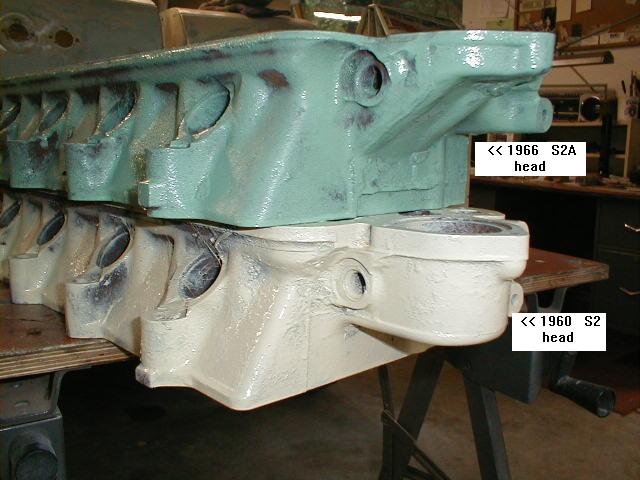Series Land Rovers
SII 2 1/4 4 Cylinder Petrol Engines compared to the IIA David Cockey

A photo of a later Series Land Rover cylinder head on top of a Series II Land Rover cylinder head showing the differences in the shape of the thermostat housings. Photo by Bob Bernard.
A recent comment that a series II engine is almost impossible to get parts for now prompted this discourse on the differences between SII and later 2 1/4 petrol engines, and the parts situation. While the SII engines have some unique parts, they are very similar to the later engines.
The new 2 1/4 litre petrol engine was announced in conjunction with the Series II announcement in April 1958. The 2 1/4 4 cylinder was the standard petrol engine in 109s from the start of SII production, and replaced the 2 litre petrol engine from the SI in 88s several months later. A number of significant revisions were made in 1961, generally coinciding with the introduction of the SIIA in September 1961. It then remained in production through the early 90s and 110s, although further modifications were made along the way, including a 5 bearing crankshaft in 1980. SII engines have 9 digit engine numbers starting with 1 while the later engine numbers have 8 digits starting with 2 and a suffix letter. Now for a comparison of the SII 2 1/4 engines and the later versions.
Carburetor and intake: same as SIIA through suffix H with Solex carburetor.
Ignition: same as SIIA with 7:1 compression ratio.
Generator: Lucas C39 rather than C40 used on SIIA.
Mounting bracket arrangement is different but the bolt holes on the generators are the same. Have a bad C39 rebuilt or replace with a C40.
Starter: same as SIIA Exhaust: 1958-60 SIIs have a manifold with a bend at the outlet, and the front pipe exits horizontally above the frame through the wheel well. 1961 SIIs and SIIA/IIIs have a manifold with the front pipe exiting straight down inside the rail. SII exhaust manifolds are available in Britain, but front pipes are difficult to find and may be close to unavailable. The standard alternative is to bolt on the SIIA/III manifold and pipes
Thermostat and housing: The 1958-69 SII have a one piece thermostat housing which uses a bellows type thermostat with a moving shroud. The 1961 SII and later use a three piece housing assembly. The bypass pipe was unique on 1961 SII (don't know reason, and don't what if anything is required to use a later outlet pipe on a SII). The 1958-60 thermostat is virtually unobtainable, so the only alternative appears to be conversion to the later SIIA/SIII arrangement. Don't be tempted to run without a thermostat, or with a different type. A cracked cylinder head may result.
Water pump: The SII and SIIA/SIII water pumps are common except for the housing. The SII has 8 bolt holes while the SIIA/III has 9 bolt holes. The SII water pump can be found but is expensive. The alternative is to rebuild a good SII housing with the same rebuild kit as used for SIIA/III.
Valve gear: SII uses two half length shafts rather than one full length shaft, and uses different brackets. The rockers, valves, etc. are the same. RN has the SII shafts in their catalog for less than SIIA/III parts.
Head casting: SII is different than SIIA, reportedly because of a tendency for the SII head to crack. (Our SII SW had a replacement head fitted when several years old) Replace a cracked SII head with a SIIA/SIII head.
Oil pump: The 1958-59 oil pump is shown in the parts books as different from the 1960 onwards pump. Differences are unknown, and I don't know if the later pump can be substituted.
Crankshaft, rods, main and rod bearings: The bearings are smaller in the SII engine compared to the later SIIA/SIII engines. Bearings are becoming very difficult to find, and original size is nigh impossible to locate. The SII petrol engines shares bearings with the 2 litre diesel. I suspect that the bearings were enlarged in 1961 with the introduction of the 2 1/4 litre diesel, and the petrol bearings were enlarged at the same time to maintain commonality. Pistons and rings: SII is the same as later engines. Front cover: SII is cast iron and different. Replacements are available, but when does it need replacing?
Block: The SII block is unique due to the different bearing diameter. Replace a cracked or otherwise unusable block with what you can find and afford. If the block is gone it may be worthwhile switching to a SIIA/III short block. Other than the differences listed above, the SII petrol engines are the same as early SIIA engines, and no more difficult to find parts for than early SIIA parts. You do need a parts book or two, do some searching and occasionally be prepared to order from the UK. There is absolutely no need to replace a SII petrol engine "just to keep it on the road" unless the engine is otherwise dead.
From the OVLR Newsletter, January 1996



















